
January 2 0 0 3
T A S T I N G N O T E S
4 2000 Ridge Zins (and a '99 Chard)
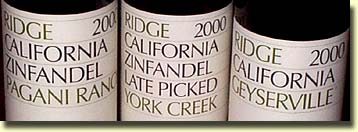
New Year's Eve found Kim and this taster in beautiful Byron, Ontario, where we celebrated with Alan Kerr, aka Canadian Zinfan, and that rascal Pascal Chambon, aka Mr. Flippy. It's occasions such as these that call for, no, that DEMAND Mr. Ridge! And that's just what we opened.
1999 Ridge
Santa Cruz Mountains Chardonnay, $29, 14.3% alc.: I was impressed by
the toasty oak and pineapple bouquet of this medium straw, and I guess Mr.
Flippy was too. “Whoa,
whoa, whoa, whoa! Ripe, ripe,
ripe pear, and something 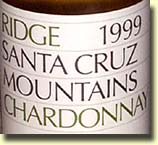 like
licorice in ze background, Pastis! Banana
on ze palate, and a lot of fresh fruit!”
The wine also shows some buttery vanilla on the palate, but not
sickeningly so like so many California Chardonnays; it’s balanced and
restrained, being full bodied, with excellent acidity and a long finish.
Lots of oohs and ahhs for this beauty, and you know that it’ll
just improve with at least a few years.
It’s a great match for crottin de chèvre
on baguette and grilled sardines and squid.
like
licorice in ze background, Pastis! Banana
on ze palate, and a lot of fresh fruit!”
The wine also shows some buttery vanilla on the palate, but not
sickeningly so like so many California Chardonnays; it’s balanced and
restrained, being full bodied, with excellent acidity and a long finish.
Lots of oohs and ahhs for this beauty, and you know that it’ll
just improve with at least a few years.
It’s a great match for crottin de chèvre
on baguette and grilled sardines and squid.
2000 Ridge Geyserville, 66% Zinfandel, 17% Carignane, 17% Petite Sirah, $30, 14.9% alc.: What can I say? This warm and friendly dark garnet just exudes all that Draper perfume, and who would expect otherwise? Kerr blurted, “Whoa, it doesn’t suck, does it,” adding impressions of “chewy, with a dusty, spicy element, like cocoa powder.” It’s all that and more, with rich raspberry, blackberry and boysenberry fruit, soft, unobtrusive tannins, good acidity and a nice finish. Flippy enthused, “It’s lovely right out of ze bottle, very well balanced in ze mouth.” Can you tell we liked it a lot?
2000 Ridge Lytton Springs, 80%
Zinfandel, 20% Petite Sirah, $30, 14.8% alc.:
Of this dark garnet, Mr. Kerr gushed, “…gobs
of glycerin…,” and Pascal added, “…I
like zis one better, it’s a lot more complex on ze nose; lots of
toffee…, compote…, jammy…”
Of course, it once again features that distinctive Draper perfume,
full of sweet raspberry and blackberry flavors and aromas, and it’s
drinking beautifully right now. Alan added impressions of “beet
and a little chocolate,” while the French guy noted “mushroom
and sweet cherry on ze finish; not as complex on ze palate as ze
Geyserville, almost one-dimensional in its fruit forward qualities, but
what fruit!” The
wine was a fine match for Kim’s grilled ribeye steak with cannellini
beans, tapenade and red wine sauce
(An
odd aside about this and another Ridge wine; we liked the 2000 LS quite a
bit when we first tasted it late last May.
While our notes were generally consistent with these, it’s
perhaps filled out some since then. However,
we tasted another in early December and it was heavy on the coconut,
unlike our initial experience or this latest one.
I was able to tolerate a second glass, but Kim wasn’t.
We had a similar experience in November, when I pulled out a ’96
Ridge Lytton Estate Syrah, one we’ve always been very fond of, and it
also reeked of coconut, making for a rather unpleasant drinking
experience. When we told our Left
Coast Correspondent Allan Bree about this, he assured us that he’d
enjoyed a bottle of the same Syrah only a few weeks before, and it was
beautiful, having none of the characteristics that we found so
disagreeable. Can you say
bottle variation, boys and girls?)
2000 Ridge Pagani Ranch
Zinfandel, 88% Zinfandel, 9% Alicante Bouschet, 3% Petite Sirah,
$27.50, 15.2% alc.: This deep dark garnet is also deeper and darker on the
nose than the Geezer or the Lytton Springs, showing blackberry, black
raspberry, plum and of course, once again, the ubiquitous Draper perfume;
a note of dark chocolate lurks here as well, and Kerr noted a touch of
eucalyptus. Flavors echo,
with silky tannins, good acidity and a long finish.
The sweet oak is perfectly balanced with the fruit; it does exactly
what it’s supposed to without dominating.
Like velvet on the palate.
2000 Ridge York Creek Zinfandel
Late Picked, 75% Zinfandel, 25% Petite Sirah, $27.50, 15.8% alc.:
The darkest garnet of the bunch?
Could be! The first
three had done an Ernie Harwell and were long gone, so we couldn’t compare,
but it sure looked that way. At
this point, comments and opinions were flying fast, and what follows are
notes by committee, such as I was able to transcribe.
“Blueberry…” – Alan
“…and something dusty…, definitely more
cooked fruit…, chocolate…” – Pascal
“…pepper…” – Alan
“…a port-like something or another…”
– geo
“…pruneau, what do you call zem?
Constipation prunes…, spicy on ze palate…, more intense…,
tannins most prominent on ze finish…, a little more minty things
here…, thicker on ze palate…, I LOVE ze finish, ze finish is HUGE!”
– Pascal
Of course, there is also a big hit of ripe raspberry, along with that
signature Ridge character, and it was not particularly discernable as a
Late Picked, especially with the memory of the 2000
Ridge Nervo from the week before still fresh.
None of these Zins show any heat to speak of, despite
the substantial alcohol levels. All
four will certainly age and improve for at least five years; in some ways,
they remind me of the ’93 vintage in that they’re very pretty right
from the get-to. The only
question is whether or not we’ll be able to keep our hands off of them
for that long. I doubt that we could be seriously faulted if we don’t!
‘T was the Sunday before X-mas,
and we got together with our friends Shar Douglas, Ken
Hebenstreit, and Bob and Kristen Lenz at Chez Lenz for
holiday wines and homemade pizzas. There
were three of the latter, with a variety of toppings that included duck
& arugula, anchovies, bacon, and an assortment of other oddball
ingredients. Is it any
surprise that they went great with Mr. Ridge?
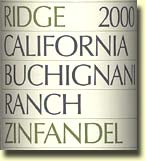 2000
Ridge Buchignani Ranch Zinfandel ATP, 81% Zinfandel, 19% Carignane,
$24, 14.6% alc.: Typically dark garnet (as were all three Zins), this
exudes an effusive bouquet of lilacs, blackberry, black raspberry and
boysenberry; Bob asked, “Is this what you call
Draper perfume?” and I could only reply to the affirmative.
The flavors echo very nicely, with a few years worth of tannins,
good acidity and a good, if not overly long finish.
More than approachable already, this will be at its best around
’04; very well received, and there’s no reason why it shouldn’t have
been.
2000
Ridge Buchignani Ranch Zinfandel ATP, 81% Zinfandel, 19% Carignane,
$24, 14.6% alc.: Typically dark garnet (as were all three Zins), this
exudes an effusive bouquet of lilacs, blackberry, black raspberry and
boysenberry; Bob asked, “Is this what you call
Draper perfume?” and I could only reply to the affirmative.
The flavors echo very nicely, with a few years worth of tannins,
good acidity and a good, if not overly long finish.
More than approachable already, this will be at its best around
’04; very well received, and there’s no reason why it shouldn’t have
been.
2000 Ridge Dusi Ranch Zinfandel ATP, $25, 14.6% alc.: This one features typically sun baked overripe black raspberry and plum flavors and aromas; Bob added impressions of “spice, like cloves.” Rich and concentrated, this will also be better in a few years when the tannins mellow down some; there’s good acidity here, and a reasonably long finish. Still, it opens beautifully with air, and no one could be faulted for opening and drinking their allotment dry tomorrow.
2000 Ridge Nervo Zinfandel Late Picked ATP, 91% Zinfandel, 9% Petite Sirah, $24, 15.7% alc.: Another overripe styled Zin, with a raspberry and blackberry bouquet that explodes from the glass and follows through beautifully on the palate; like the other two ATP wines tasted on this occasion, it has a few years worth of tannins, good acidity and a more than decent finish. It’s sweet, but not late harvest sweet; Kim exclaimed, “Oh my!” upon her first whiff of this, and after tasting it, she proclaimed it “eminently drinkable.” Don’t know what more needs to be said after that!
6
From Flowers
It
had been almost 2 years since
we last tried these first two wines, and I thought it was time to see
how they were coming along, especially since they’d be paired with a
plump duck imbued with rosemary and garlic.
As it turns out, I wonder if we shouldn’t have opened them last
Thanksgiving instead of this.
1997
Flowers Sonoma
Coast Pinot Noir Camp
Meeting Ridge, 13.8%
alc.: This ruby dark garnet is showing just a hint of brick at the rim,
and exudes those typically perfumed and ever so slightly yeasty sweet oak
(but not overly so for my tastes), smoky black cherry aromatics that were
the signature of the La Follette era at Flowers.
Neither as bright nor as sweet on the palate, it features earthy
black cherry and plum flavors that lose some intensity from the mid-palate
back on through the finish. There’s
good acidity here, and some tannins still to resolve, but I doubt that
it’ll improve with age. A
decent Pinot, though nothing special at this point, but then it never was
one of my favorite CMR vintages.
1995
Flowers Sonoma Coast Pinot Noir Camp Meeting Ridge,
13.5% alc.: Another ruby dark garnet that’s also showing a little
bricking, this is has a deeper, darker version of the smoky black cherry
perfume than the ’97, and yet it’s a little shyer at the same time.
And like the ’97, it loses the sweet oak and brightness when it
hits the palate, where it comes on with forest floor, black cherry and
plum characteristics. It’s
still tannic, but not so much so you can’t drink it with a little air;
it also has a slightly oily, petrol-like note that adds some interest for
this taster, and some cinnamon and chocolate come out with air.
Probably the better of the 2 wines, but having the same general
strengths (bouquet) and weaknesses (declining fruit).
If
either of these should develop some secondary nuances to compensate for
the fading fruit, they could become more interesting down the road, but
there’s no indication of that happening at this point, so I say drink
‘em soon if you got ‘em. Both
have since been retasted, with consistent results.
After sampling those, we wondered how the prestige Moon Select bottlings from the same vintages were fairing.
1995 Flowers Sonoma Coast Pinot Noir Camp Meeting Ridge Moon Select, 13.5% alc.: Still a dark garnet showing no rust to speak of, this big boned Pinot exudes an immediate note of bacon, along with lovely plum, black cherry and that slightly yeasty thing that seems to be a signature of Flowers wines. There’s plenty of fruit, and still some significant tannins to resolve here; the acidity is good and so is the finish. A note of chocolate emerges as it smoothes out with air, while the bacon recedes. There has been some criticism of this wine in the past, being to the effect that the fruit will never outlast the tannins, but I've never bought that line, and indeed, while it’s starting to drink pretty well already, it should improve over at least the next few years.
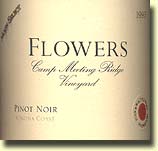 1997
Flowers Sonoma Coast Pinot Noir Camp Meeting Ridge Moon Select, 14.2%
alc.: Another dark garnet, this one is showing a lot more oak than the
’95 Moon Select. Featuring
flavors and aromas of yeasty oak, black cherry, plum, a touch of chocolate
and what Alan Kerr described as “a lot of maraschino cherry,” this has
nice depth and concentration, with a fairly long finish.
There are tannins for a few more years in the cellar, but there’s
no reason you can’t decant one for an hour and drink it tonight.
Not quite up to the ’95, but a solid Pinot Noir nevertheless.
1997
Flowers Sonoma Coast Pinot Noir Camp Meeting Ridge Moon Select, 14.2%
alc.: Another dark garnet, this one is showing a lot more oak than the
’95 Moon Select. Featuring
flavors and aromas of yeasty oak, black cherry, plum, a touch of chocolate
and what Alan Kerr described as “a lot of maraschino cherry,” this has
nice depth and concentration, with a fairly long finish.
There are tannins for a few more years in the cellar, but there’s
no reason you can’t decant one for an hour and drink it tonight.
Not quite up to the ’95, but a solid Pinot Noir nevertheless.
And, as long as we were at it, we
decided to see how a couple of the '98s were faring...
1998
Flowers Sonoma Coast Pinot Noir Camp Meeting Ridge, 13.2% alc.: This
ruby dark garnet shows the typical slightly yeasty, smoky black cherry and
plum characteristics that are associated with Flowers Pinots; aromatics
are bright and pretty, though not overly effusive, while the flavors are
considerably more expressive. This
is drinking as well as it ever has in our experience, with silky tannins,
zippy acidity and hints of licorice and chocolate that come out with air;
a decent finish turns a little tarry.
It has never threatened to be a great wine, but it’s certainly
turned into a pretty good one, and is especially nice with Kim’s
brocolli rabe sautéed with garlic and onions, Yukon potato and blue
cheese gratin and pan roasted pork tenderloin rubbed with Maille Mustard,
cracked fennel seeds, rosemary and pepper corns.
1998
Flowers Santa Lucia Highlands Pinot Noir Pisoni, 13.5% alc.:
Unfortunately, this slightly cloudy ruby garnet isn’t holding up as well
as the ’98 CMR; while it exhibits effusive yeasty toasty oak, smoke,
black cherry and sweet spices on the nose, the earthy black cherry and
plum flavors seem somewhat dull in comparison, with a few years worth of
tannins still to lose, good acidity and a so-so finish.
It was better a year of two ago, and reminds me of one of those
Burgundies that you never heard of, but take a chance on because of a
silver-tongued shelf talker, then just doesn’t live up to the hype.
The tannins need at least two years, but what will happen to the
fading fruit in the meantime? Don’t
get me wrong, the wine ain’t “bad,” but it’s definitely on the
downside, so drink up.
3
From Salentino
After
making certain comments recently about a perceived decline in the quality
of Taurino’s Salice Salentino in the mid-90s vintages, I got a guilty
conscience and decided it was only fair to see how this and the southern
Italian producer’s other QPR stalwart, Notarpanaro, were tasting these
days. We loved several vintages previous to and including the 1990,
but after that, 3 or 4 so-so bottles failed to impress, and our attention
drifted. Happily, both of the
current versions are decidedly more appealing than those last few.
We threw in another Salice Salentino that was sitting on the same
shelf as these, recognizing an obvious tasting opportunity when we saw
one.
1998
Taurino Salice Salentino Riserva, 80% Negroamaro, 20% Malvasia Rossa,
$9.99, 13.5% alc.: Right away, this slightly rusty ruby dark garnet shows
a little heat on a big noseful of smoke, raisin, leather, dried black
cherries, and a little licorice. At
first, the flavors are more toward the fruit end of the spectrum, with a
nicely assertive dried cherry and raisin character, with the other
elements playing restrained supporting roles, but as it opens over 3 hours
and more, it really starts to rock and roll, getting deeper and richer.
Flavors echo the bouquet more and more, gaining a note of licorice
while the varnish mutates into root beer, cola and Brasso ®.
There’s at least a few years worth of tannins here, with nice
acidity and a decent finish. A
nice glass of wine with Kim’s home made pizza, both the anchovy and
cilantro versions.
Imported
by Winebow Inc., New York, NY 10010
Winebow Inc., New York, NY 10010
1997
Leone de Castris Salice Salentino Riserva, $13.99, 13% alc.: Rather
different than the Taurino, this inky purple garnet almost seems more like
Bordeaux or a Rhone at first, with it’s somewhat earthy, barnyard-y
black currant and plum bouquet. Smooth
and full bodied, the flavors lose the funk, but maintain the same black
currant and plum character, with a good 5 years of tannins anyway, decent
acidity and a nice finish that might lengthen as the tannins mellow.
Hints of dried cherries, chocolate and raisins emerge as this
opens, never playing leading roles in the flavor profile, but always
lending a nice spicy accent. This
one is also very good with Kim’s pizza.
Imported
by A.V. Imports, Inc., Columbia, MD
Both
of these are tasty, and well worth the money.
As Kim put it, “I could drink these wines every day!”
1995
Taurino Notarpanaro, $12.99, 13.5% alc.: This inky dark garnet is
essentially a souped-up single vineyard (named Notarpanaro, of course)
Salice Salentino, and it’s much more impressive than the last few that
lost our interest back when. It
features big flavors and aromas of licorice, smoke, tar, dried black
cherry, and hints of bitter chocolate and root beer-cola.
With plenty of tannins and acidity and a long finish, it’s a bit
hot on the nose and the palate, but still drinking pretty well already.
Past vintages have proven to be 10-year wines and more, and this
seems to have all the stuffing to be one of those.
I’m sorry I neglected these for the past few years, as I may have
missed another good vintage or two. Highly
recommended, but your best bet is to put it down for at least 3 more
years, and probably 5.
Imported
by Winebow Inc., New York, NY 10010
2 from Verget
Alan Kerr showed up at our door a while back with these two bottles in hand, and we wasted little time in opening them and seeing what they had to offer. What we found was very much to our liking.
1999 Verget Meursault “Rougeots,” $29, 13 alc.: This medium straw even LOOKS thick; it exudes a green apple, pear and lime bouquet, with some creamy oak nuances that really come out in the flavors, along with a good dose of minerality. It has good intensity, excellent acidity, a fairly thick texture and good length on the finish; frankly, we found it to be delicious. CZ remarked, “It’s SO refreshing to drink a Chardonnay like this; it can go 5 years easy,” and indeed, I’d love to taste one at least a few years down the road. It pairs well with smoked chicken, which brings out a bit of the toastiness in the oak; after it’s been open for an hour or so, toasty vanilla really emerges, which might turn some people off. Of course there’s a simple solution to that; suck it down in less than an hour! Hah!!!
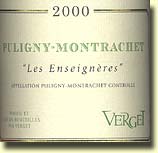 2000
Verget Puligny-Montrachet “Les Enseignères,”
$35, 13% alc.: Another medium straw, this is a little sweeter and a little
spicier on the green apple, pear and mineral nose than the Meursault;
it’s also a little creamier on the palate, with excellent acidity and
intensity. Kerr observed,
“There’s much more of a lamp oil feel to this; it’s more viscous.
The pear is riper; it’s quite lovely.”
With a little air, I found a bit of cucumber flesh on the nose,
while CZ noted some lime zest, mineral and peach or nectarine on the
palate. Kim got a bit of what
she called “dime store turtle water,” saying one would have to have
grown up back in the ‘60s to know what she was referring to.
Alan likes the complexity of the Meursault and the balance of the
Puligny-Montrachet, but as the latter opens over time it actually develops
considerably more complexity than the “Rougeots;” CZ rattled off added
impressions of butterscotch, creamy toffee and hints of licorice.
This is another one that would be interesting to see what develops
with some time in the bottle.
2000
Verget Puligny-Montrachet “Les Enseignères,”
$35, 13% alc.: Another medium straw, this is a little sweeter and a little
spicier on the green apple, pear and mineral nose than the Meursault;
it’s also a little creamier on the palate, with excellent acidity and
intensity. Kerr observed,
“There’s much more of a lamp oil feel to this; it’s more viscous.
The pear is riper; it’s quite lovely.”
With a little air, I found a bit of cucumber flesh on the nose,
while CZ noted some lime zest, mineral and peach or nectarine on the
palate. Kim got a bit of what
she called “dime store turtle water,” saying one would have to have
grown up back in the ‘60s to know what she was referring to.
Alan likes the complexity of the Meursault and the balance of the
Puligny-Montrachet, but as the latter opens over time it actually develops
considerably more complexity than the “Rougeots;” CZ rattled off added
impressions of butterscotch, creamy toffee and hints of licorice.
This is another one that would be interesting to see what develops
with some time in the bottle.
Imported by: Barrique Wine Company, Chicago, IL 60640
More Good Stuff
 1998 Seña Red
Table Wine Aconcagua Valley,
90%
Cabernet Sauvignon, 5% Carmenère, 5% Merlot, $22, 14.0% alc.:
No, that’s not a typo on the price tag; we got this dark garnet Robert
Mondavi – Eduardo Chadwick collaboration for less than half of the
release price, thanks to a close-out and a timely tip from our friend Mike
Brenton. We opened
one for Kim’s birthday dinner and were most impressed with this
beautiful Chilean claret. It
exudes a lovely bouquet of cassis, black currant and plum, accented with
hints of lead pencil, shoe polish and a subtle floral nuance that only
enhances the considerable appeal. The
rich, delicious flavors echo generously, with good acidity, a long finish
and silky tannins that will take it several years down the road.
A marvelous combination of power and finesse, this was a fine
compliment to Kim’s delicious beef daube (she wasn’t in the mood for
my deluxe Hot Dog Soup ®). One
of the nicest surprises we’ve run into in a long time, and an incredible
bargain to boot.
1998 Seña Red
Table Wine Aconcagua Valley,
90%
Cabernet Sauvignon, 5% Carmenère, 5% Merlot, $22, 14.0% alc.:
No, that’s not a typo on the price tag; we got this dark garnet Robert
Mondavi – Eduardo Chadwick collaboration for less than half of the
release price, thanks to a close-out and a timely tip from our friend Mike
Brenton. We opened
one for Kim’s birthday dinner and were most impressed with this
beautiful Chilean claret. It
exudes a lovely bouquet of cassis, black currant and plum, accented with
hints of lead pencil, shoe polish and a subtle floral nuance that only
enhances the considerable appeal. The
rich, delicious flavors echo generously, with good acidity, a long finish
and silky tannins that will take it several years down the road.
A marvelous combination of power and finesse, this was a fine
compliment to Kim’s delicious beef daube (she wasn’t in the mood for
my deluxe Hot Dog Soup ®). One
of the nicest surprises we’ve run into in a long time, and an incredible
bargain to boot.
Imported
by RM Imports, Napa, CA
1987 Michele Chiarlo Barolo, 13.5% alc.: The first of two fine Italian reds that Alan Kerr pulled from his cellar during one of our recent visits, this dark garnet is showing just a touch of amber. The earthy red current and raspberry flavors and aromas are shaded with sweet spicy cinnamon and a bit of sour cherry. There’s plenty of acidity here, some tannins still to resolve and a nice, if not overlong finish. A terrific accompaniment to Alan’s delicious gigantic grilled veal chops and rosti.
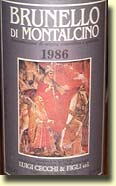 1986
Luigi Cecchi & Figli Brunello di Montalcino, 13.5% alc.: A ruby
dark garnet, this is showing little if any brick, and it has an effusive
bouquet of sweet raspberry, black cherry and red currant, with just a hint
of tar in the background. The
flavors echo loudly, with fully resolved tannins, perfectly balanced
acidity and a lovely finish. CZ
called it “a gem,” noting “a sunbaked pruniness with air,” and
agreed with me that it was more than a little reminiscent of the marvelous
’71 Ridge York Creek Petite Sirah tasted last May during Ridgestock.
1986
Luigi Cecchi & Figli Brunello di Montalcino, 13.5% alc.: A ruby
dark garnet, this is showing little if any brick, and it has an effusive
bouquet of sweet raspberry, black cherry and red currant, with just a hint
of tar in the background. The
flavors echo loudly, with fully resolved tannins, perfectly balanced
acidity and a lovely finish. CZ
called it “a gem,” noting “a sunbaked pruniness with air,” and
agreed with me that it was more than a little reminiscent of the marvelous
’71 Ridge York Creek Petite Sirah tasted last May during Ridgestock.
1999 Poggio Valente, $29, 11-14% alc.: Bob and Kirsten Lenz are fond of this dark garnet Tuscan, and indeed, it more than held its own in the midst of the Ridge ATP Zins noted above. It has a certain roasted quality, along with hints of a root beer-like nuance over deep dark black fruit character; Bob mentioned “some cherry, blackberry, shoe polish and forest going on.” The tannins acidity and finish are all good, and a few hours in a decanter no doubt helped this young Eye-talian whelp open up and tone down nicely. A 10-year wine, so be patient.
1999 Fairhall Downs Sauvignon Blanc Marlborough, 13% alc.: It's been over a year since we last tasted this medium straw, and it's still going strong, with its bold grapefruit nose that follows through and gains a lemony snicket on the palate, with good concentration and intensity, excellent acidity and a nice finish. Under $15 Canadian makes for some excellent QPR here.
2001 Mulderbosch Sauvignon Blanc Stellenbosch, $20.95 Canadian, 12.5% alc.: We’ve enjoyed versions of this pale straw colored wine going back to the ’97 vintage, and this one is a worthy successor to the line, with straightforward grapefruit and pear flavors and aromas. Clean and crisp, and more expressive on the palate than the nose, it features the requisite lively acidity and a decent finish, making for some good QPR at this price.